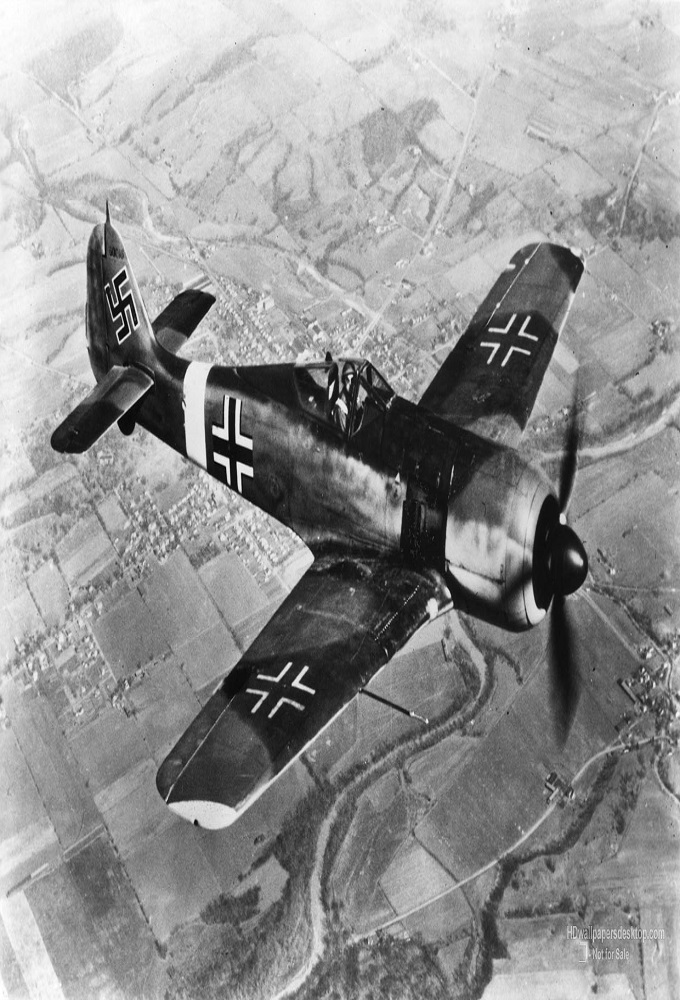
German War Files
Non notée
Année : 2004
Nombre de saisons : 1
Durée moyenne d'un épisode : 60 minutes
Genre(s) : Documentaire, Histoire, Mini-série, Guerre
This War Archive set of exclusive programs brings the most comprehensive collection of the Wehrmacht's mobile fighting armor probably ever compiled as a definitive series. The Panzer and Tiger tanks in their various configurations swept all before them throughout Europe, Russia, and the Middle East in the Blitzkreig campaigns. The series deals with the evolution of each tank, many of which were judged to be the best designed tanks of the war.
Saisons

Saison 1
Épisodes
Choisissez votre saison au dessus et découvrez les épisodes qui vous attendent !
Épisode 1 - Dive Bombers & Combat Aircraft of WW2
16 février 2004
For many in the opening years of the Second World War, the vision of the menacing, gull-winged Stuka dive bomber, plunging vertically earthwards, its sirens wailing like banshees before releasing its bomb load, became the very embodiment of the terror created by the new form of 'Blitzkrieg' warfare unleashed on Europe by the German Wehrmacht in September, 1939. Designed to assist ground operations, the Stuka was always to be found operating with the leading elements of the army in France, North Africa, and Russia as 'flying artillery'. In this wide-ranging presentation the Stuka is seen in action on all fronts, as well as the Hs-129s and Fw-190 in action in Russia.
Épisode 2 - German Fighter Aircraft of WW2 1939-1942
16 février 2004
The German Luftwaffe entered World War II in September 1939, employing as its main day fighter the Messerschmitt Bf-109, one of the classic fighter aircraft designs of all time. When war broke out, it was already riding high on a reputation derived from its successful blooding in the Spanish Civil War. 1941 saw the introduction of the Focke Wolf Fw-109 over the English Channel. Its superiority over the Spitfire Mk. V saw it rapidly become the Luftwaffe fighter arm's 'second iron' and was to play a major role in the widening conflict from 1941 onwards. This programme covers the operations of the Bf-109 in its role on all fronts, to 1942 and the early missions by the Fw-190 over France and the English Channel.
Épisode 3 - German Fighter Aircraft of WW2 1942-1945
16 février 2004
The reality of the air-war over Germany is demonstrated in this programme, illustrating the battles fought by the Luftwaffe day fighter squadrons in their attempts to frustrate the ever growing US and Allied bomber raids.
Épisode 4 - German Night Flyers of WW2
16 février 2004
Using combat footage from all fronts and from film shot in the skies by night and day over Germany, this programme provides a dramatic account of the contribution made by the heavy fighters of the Luftwaffe in World War 2.
Épisode 5 - Bombers & Bombing Raids 1939-1942
16 février 2004
A look at combat operations from North Africa through to Northern Norway,the Atlantic approaches to the Battle of Stalingrad,and the role of the Luftwaffe's bombing in the period of Germany's military expansion between 1939 and 1942.
Épisode 6 - Bombers & Bombing Raids 1942-1945
15 mars 2004
This episode covers German bombers during the final years of the war. Included are a review of German seaplanes and flying boats, including the Blohm & Voss 238, the heaviest aircraft ever flown at that time; the Hs 293 anti-ship missile, dropped from He 111s; the He 177 'Griffon' heavy bomber, and more.
Épisode 7 - German Support Aircraft & Gliders of WW2
15 mars 2004
Covered in this program are glider operations in Italy, and even the employment of DFS 230s to re-supply garrisons on the Oder front in 1945. Also shown are reconnaissance, trainer and liaison aircraft, which made a vital contribution to the role of the Luftwaffe on all fronts in the Second World War.
Épisode 8 - German Jets & V1 & V2 Flying Bombs of WW2
15 mars 2004
The assumption that the RAF's long-range reconnaissance aircraft, the Mosquito, could continue to employ its high speed to range across German with impunity, was shattered on 25th July 1944. A Mosquito, belonging to the No.544 squadron, barley escaped destruction after having been attacked in the first air-to-air encounter with the revolutionary new German fighter, the Messerchmitt Me-262.
Épisode 9 - The Green Devils: German Paratroopers Elite 1933-1941
15 mars 2004
First seeing action during Operation Weseruburg - the invasion of Denmark and Norway in April 1940 - the Green Devils were the 'fallschirmjaeger' (paratrooper) arm of the Luftwaffe and were to see extensive service in both air drop and ground roles, through to the war's end in 1945. The first paratrooper unit was raised in 1935 following the profound impression made upon the Germans by the early experiments with this new form of warfare conducted by the Soviets. This programme deals with the evolution of the paratrooper arm, and goes into depth about their important role in the invasion of the West in 1940. it also offers extensive coverage of the victorious operation that will remain forever linked with the fallschirmjaeger Operation Merkur - the invasion of Crete in 1941.
Épisode 10 - The Green Devils: German Paratroopers Elite 1942-1945
15 mars 2004
First seeing action during Operation Weseruburg - the invasion of Denmark and Norway in April 1940 - the Green Devils were the 'fallschirmjaeger' (paratrooper) arm of the Luftwaffe and were to see extensive service in both air drop and ground roles, through to the war's end in 1945. The first paratrooper unit was raised in 1935 following the profound impression made upon the Germans by the early experiments with this new form of warfare conducted by the Soviets. This programme deals with the evolution of the paratrooper arm, and goes into depth about their important role in the invasion of the West in 1940. it also offers extensive coverage of the victorious operation that will remain forever linked with the fallschirmjaeger Operation Merkur - the invasion of Crete in 1941.
Épisode 11 - Guns of the Wehrmacht 1933-1945
19 avril 2004
The effectiveness of its artillery arm was one of the dominating features of the German Army on the battlefields of the Western Front in the First World War. Indeed, a specific requirement of the Treaty of Versailles was that the new Reichswehr be denied heavy artillery. The expertise and technology that had made the artillery arm so effective in that conflict were never lost. So that when re-armament began in Germany 1933, following the Nazi accession to power, the ground was already laid for the rapid expansion of artillery of all types for the new Wehrmacht. While never acquiring the glamour of Panzer arm, the guns of the Wehrmacht were nevertheless instrumental in serving the German Armed Forces in victory and defeat through to 1945.
Épisode 12 - Hummel: Mobile Heavy Artillery
19 avril 2004
From 1940 until war's end, German industry produced a plethora of self-propelled weapons for the German Army. Whilst some of these were purposely designed, others were extemporary affairs developed rapidly using available weapons and chassis to serve the immediate need of the German Army in the field. Those covered in this programme fall mainly into the categories of tank destroyers and self-propelled artillery. This unique compilation of combat footage of these vehicles will allow the viewer to gain an insight into the variety and importance of such weapons to the German Army, up to its defeat.
Épisode 13 - German Military Vehicles Including Armoured Cars & Half Tracks
19 avril 2004
La seconde Guerre Mondiale est terminée depuis bientôt soixante dix ans et pourtant, les historiens et experts militaires poursuivent recherches et réflexions sur les raisons de l'extraordinaire réussite des armées d'Hitler au début du conflit et les causes multiples de l'échec final. Et aujourd'hui, à côté des avions et des chars, le rôle déterminant joué par les automitrailleuses et les semi-chenillés émerge clairement. Aucune armée au monde n'avait et n'a jamais depuis disposé d'une telle variété de véhicules de combat, adaptés à toutes les formes d'engagement et de missions sur tous les champs de batailles, quelque soit le terrain.
Épisode 14 - Panzer: Germany's Ultimate War Machine
19 avril 2004
During WW2, the need for capable and qualified crewmen to work with and maintain the equipment became vital. In order to keep up with the demands of warfare, soldiers and engineers were educated partly with training films. This programme shows footage of the Tiger tanks during Operation Citadel, as well as edited highlights of two German Army training films from late 1943 and mid 1944.
Épisode 15 - Panzer I & II: Germany's WW2 Light Tank
19 avril 2004
L'une des idées toutes faites sur la seconde guerre mondiale reste encore celle que les victoires allemandes, au début du conflit, furent remportées grâce à la suprématie des chars allemands sur ceux de la Grande Bretagne, de la France et de l'Union soviétique. La suprématie numérique était incontestable mais ce fut surtout la supériorité tactique de l'état major du IIIème Reich qui emporta haut la main la décision. En effet les panzers I et II qui équipaient majoritairement les unités blindées étaient, au début de la guerre, déjà dépassés ! Les chars alliés étaient, pour la plupart plus puissants, mieux armés, en un mot technologiquement supérieurs. Mais le génie militaire des généraux Guderian, Rommel et Von Manstein dans l'utilisation des blindés fit largement la différence. Cette suprématie fut particulièrement éclatante dans le déroulement de la bataille de France et des batailles qui suivirent, jusqu'en 1942.
Épisode 16 - Panzer III: Germany's WW2 Medium Tank
19 avril 2004
Produit dès 1938, ce n'est qu'à partir de d'avril 1940 que le panzer III, modèle L, se développa vraiment. Dans sa version initiale, il était équipé d'un canon de 37 mm, insuffisant. Il fallut attendre plusieurs mois pour que ce grave défaut soit corrigé et ce malgré l'insistance de Guderian et de Hitler lui même. Le Panzer III fut alors doté d'un canon de 50mm, à tube court et enfin, plusieurs mois plus tard, du canon L60 à tube long, celui que le Führer réclamait depuis la campagne de France. Le Panzer III enfin bien armé, fut engagé dans toutes les offensives sur le front russe. Mais les chars soviétiques se révélèrent remarquablement mobiles sur tous les terrains, bien protégés et bien armés. La titanesque bataille de Koursk qui vit des milliers de blindés s'affronter, mit fin à la carrière du Panzer III en tant que char de combat.
Épisode 17 - Panzer IV: Germany's WW2 Heavy Tank
19 avril 2004
En découvrant le prototype du nouveau char Panzer IV en 1936, peu nombreux étaient ceux qui pouvaient se douter être en face de l'arme qui allait devenir le cheval de bataille de l'armée allemande. Au départ le rôle du Panzer IV, char moyen, était de prêter main forte au Panzer III plus petit et plus léger mais qui allait constituer l'épine dorsale des nouvelles Panzerdivisions. La suite des évènements allait prouver que la Wehrmacht, en concevant un char avec une caisse et une tourelle plus grandes avait créé un engin dont le potentiel dépassait largement celui des Panzer III. Dés 1942, ces derniers devenus obsolètes laissèrent leur place aux Panzer IV. Il fut produit durant toute la seconde Guerre Mondiale. Mais son histoire ne s'arrête pas en 1945. Les derniers obus tirés par un Panzer IV le furent pas les Syriens contre Tsahal sur le plateau du Golan en 1967. 7350 exemplaires toutes versions confondues furent fabriquées entre 1938 et 1945.
Épisode 18 - Panther: The Panzer V
19 avril 2004
Conçu et fabriqué en un an, pour faire face aux redoutables T-34 soviétiques, le Panzer V est resté dans l'histoire sous le nom de Panther. Il fit ses premières armes en 1943 lors de la bataille de Kursk, point fort de l'opération Citadel. Le Panther n'était pas un char lourd. Il pesait 45 tonnes, était particulièrement manoeuvrable et son formidable long canon détruisait un T-34 à 3000 mètres avec des obus de 75 mm ! Mais ce n'est qu'en mars 1944, après des débuts difficiles dus à la rapidité de sa conception, que le Général Guderian le déclara pleinement apte au combat. Jusqu'à la chute de Berlin, en mai 45, le Panther fut en première ligne dans tous les combats ; bataille de Normandie, bataille des Ardennes, toutes les actions de résistance désespérée à l'avancée de l'Armée Rouge, partout, les Panther furent des combattants impitoyables. Cette vidéo, à travers l'histoire de ce char mythique, retrace les trois années de guerre les plus meurtrières du second conflit mondial.
Épisode 19 - Tiger: Germany's WW2 Heavy Tank Panzer VI
19 avril 2004
Très rapide et manoeuvrant malgré ses 56 tonnes, armé d'un canon de 88mm, le plus destructeur de tous les canons équipant les autres chars, amis ou ennemis, très précis jusqu'à 2 700 mètres , le TIGRE était le fleuron de l'industrie militaire allemande. Il apparaît pour la première fois sur le front russe en 1942 et les derniers TIGRE encore en état défendront Berlin en 1945. Ce symbole de puissance du IIIème Reich ne fut pourtant fabriqué qu'à 1500 exemplaires car d'autres types de blindés plus simples à monter et à entretenir mobilisèrent les chaînes de production. Les images d'archive ne laissent aucune place au doute sur la redoutable efficacité du Tigre au combat.
Épisode 20 - Assault Guns: Stug III & Stug IV
19 avril 2004
1936. Le général Von Manstein lance l'étude d'un véhicule blindé chenillé, sans tourelle pivotante, pour le soutien de l'infanterie. Se doutait- il qu'il donnait naissance à un blindé qui allait jouer un rôle de première importance dans l'armée allemande, du début à la fin de la guerre ? Ces canons d'assaut surnommés StuG, abréviation de Sturmgeschütz vont, très vite, dépasser le rôle de soutien d'infanterie pour lequel ils avaient été conçus et devenir de redoutables "tueurs de chars". Les StuG III et les StuG IV, à canon court ou long, seront fabriqués à des milliers d'exemplaires, car leur production était plus facile et moins onéreuse que celle des Panzers. Ils afficheront plus de 30 000 chars russes à leur tableau de chasse ! Des images de combat saisissantes permettent de suivre les exploits de ces blindés, moins célèbres que les Panzer, mais dont la valeur guerrière est aujourd'hui reconnue.
Vidéos
Oups aucune vidéo pour le moment... Revenez plus tard pour des aventures en images !

Aucun avis pour le momment...